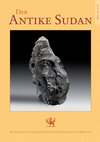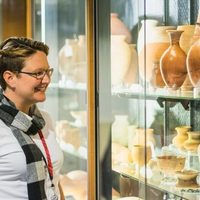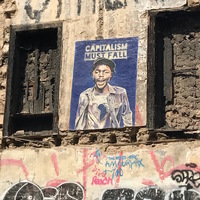Papers by Malykh Svetlana

Stratum plus. Archaeology and Cultural Anthropology
The paper analyzes the results of the work of the Russian Archaeological Mission of the Institute... more The paper analyzes the results of the work of the Russian Archaeological Mission of the Institute of Oriental Studies of the Russian Academy of Sciences at Giza in 2013, 2017, and 2019—2020. During these seasons, the team recorded a unique double infant burial in an amphora in rock-cut tomb GE 49 (the southern section of the Russian concession) and a cemetery to the west of the rock-cut tomb of Kakherptah (the north-western section of the Russian concession). The internments are dated to the first half of the 1st millennium B. C. The infant burial in an Egyptian amphora of Dynasty XXI (1070/1069—946/945 BC) has been preserved in fragments. However, part of the accompanying inventory has survived and is represented by a beaded bracelet and a scarab amulet. Of the 29 burials in the cemetery near the tomb of Kakherptah, 11 belonged to children. They are mostly well preserved, allowing us to study the features of burial rites, which included inhumation in an extended position on the bac...
Oriental Courier, 2020
The article presents archaeological study of the ancient Egyptian burial shaft in the rock-cut to... more The article presents archaeological study of the ancient Egyptian burial shaft in the rock-cut tomb of official Perinedju, undertaken by the Russian Archaeological Mission of the Institute of Oriental Studies RAS in 2019. Late material discovered during the work indicates the stages of repeated human penetration into the shaft, as well as the remains of the original burial of the Old Kingdom were found. However, the interpretation of some finds presents significant difficulties and leaving many questions about their original purpose.
Pottery samples recovered from Abu Erteila (Sudan) – Correlation of macroscopically identified fabrics with laboratory-defined raw material groups, 2017
This article reports on the use of laboratory analysis to examine whether pottery recovered
from ... more This article reports on the use of laboratory analysis to examine whether pottery recovered
from excavations at Abu Erteila includes wares made at the same workshops
as pottery found at other Meroitic sites in the region. It also examines whether wares
deemed typical of the Abu Erteila ceramic assemblage were made of the same raw
materials as pottery at neighbouring sites or clay used at other workshops. Particular
attention was paid to assessing whether samples with fabrics which macroscopically
resemble the Musawwarat fabrics were indeed made at workshops in Musawwarat or
whether this macroscopic similarity is deceptive.

Der Antike Sudan. Mitteilungen der Sudanarchäologischen Gesellschaft zu Berlin e.V. , 2018
In 2013–2015, during the excavations of the temple in Abu Erteila by the Joint Italian-Russian Ar... more In 2013–2015, during the excavations of the temple in Abu Erteila by the Joint Italian-Russian Archaeological Mission (Republic of the Sudan), fragments of two rectangular pottery vessels were found, one of them with traces of ankh-sign inside. Similar objects both of ceramics and sandstone were discovered in other sites of Meroitic region. Comparative analysis made it possible to establish that the vessels were basins for the ritual libation of water and other liquids in the Meroitic temples and pyramid chapels of different dedication. This indicates a partial uniformity of the temple ceremonies in Meroitic Kingdom, which not belonged to the cult of precise deity or a king. Ceramic utensils for cult activities were probably made in local pottery workshops near the temples. It can also be assumed that the form of the ritual of water libation using special vessels takes its origins in the ancient Egyptian temple practice.
The review gives a critical assessment of the new textbook on the history of the Ancient Orient ... more The review gives a critical assessment of the new textbook on the history of the Ancient Orient (Zakharov A. O. The History of the Ancient Orient. A course of lectures for bachelors in the field of foreign studies 41.03.01. Moscow: Institute of Oriental Studies of the Russian Academy of Sciences, Institute of Oriental Countries, 2016. 286 pp., ill., maps), prepared specifically for students in regional studies.
Вестник Института востоковедения РАН / Journal of the Institute of Oriental Studies RAS, 2018
The article is devoted to the interpretation of ancient Egyptian ceramic material of the second h... more The article is devoted to the interpretation of ancient Egyptian ceramic material of the second half of the 3rd millennium B.C., discovered by the Russian Archaeological Mission (IOS RAS) in the Minor Cemetery in front of the tomb of Tjenty I in the eastern part of Giza Necropolis. The pottery found in the filling of the burial shafts allows to consider various aspects of ancient Egyptian burial constructions. We can suppose that originally these ceramics belonged to the cult equipment of one of the great mastaba-tombs of the royal relatives on the Eastern Plateau of Giza, which was subsequently reused to fill more modest burial shafts on the eastern edge of Eastern Giza.
The anonymous Old Kingdom rock-cut tomb GE 23 adjoined to the tomb of Perseneb (LG 78) from the n... more The anonymous Old Kingdom rock-cut tomb GE 23 adjoined to the tomb of Perseneb (LG 78) from the north ( ); the last one was dated to the late Vth Dynasty-early VIth Dynasty. 1 The tomb GE 23 consists of a cult chapel with two burial shafts, as well as the shaft GE 40A was attached to this tomb outside from the east. The rock-cut niche GE 40N is situated to the north from the shaft GE 40A ( ).
Вестник Института востоковедения РАН, 2018
The mass ceramic material discovered by the Russian Archaeological Mission of the IOS RAS during ... more The mass ceramic material discovered by the Russian Archaeological Mission of the IOS RAS during 22 years of research in the eastern part of the ancient Egyptian Giza Necropolis belongs to a significant chronological interval from the reign of the Dynasty IV (26th–25th centuries B.C.) till the 19th century A.D. It is an indicator of the chronological multilayeredness of Giza, allowing to recreate a phased picture of the life of this archaeological site – from specific functional features of the ancient cemetery through periods of robberies and creation of secondary burials to the use of tombs as dwellings by Christian and Islamic population of Egypt. The full history of the formation and existence of the eastern part of Giza Necropolis is thus about 4.5 thousand years.
Vostok (Oriens), 2017
В статье анализируется керамический материал Абу Эртейлы – памятника Мероитской цивилизации (Севе... more В статье анализируется керамический материал Абу Эртейлы – памятника Мероитской цивилизации (Северный Судан), относящегося к III в. до н. э. – V в. н. э. На его основе, а также учитывая данные южных пригородов столицы царства Мероэ (Хамадаба, Аулиба), предполагается cуществование собственной гончарной мастерской в каждом таком поселении, которая использовала особую маркировку для керамических изделий и местное сырье при общем морфо- логическом сходстве керамических типов, производимых в таких гончарнях. В то же время на поселения привозились и изделия других мастерских, прежде всего столицы, что видно по присутствию на памятниках качественной каолиновой тонкостенной керамики.

Vestnik drevnei istorii, 2016
Eleven small relief vessels from the collection of Moscow Pushkin State Museum present different ... more Eleven small relief vessels from the collection of Moscow Pushkin State Museum present different characteristic samples of the Greco-Egyptian terracottae. According to the clay fabrics, they probably originated from the workshops of Memphis (Memphis Black Ware type), Fayum, Naukratis and Alexandria. One alabastron is supposed to come from Middle Egypt and two others are of unknown origin. Unfortunately, the provenance of all pieces is not known. Nine of them came from the former collection of V. Golenischev, and two others were acquired from private collections of A. Zhivago and I. Arutyunyan.
As it seems, the vessels with Dionysian symbolic were used as votive offerings in temple rituals, while the rest were used for aroma, cosmetic and medical substances storage.
Decoration of the relief vessels demonstrates themes which were traditional in Greco-Egyptian coroplastic art of that time. The main subjects and symbols were connected with syncretic Hellenistic and Egyptian pantheon: Bes, Dionysos, Eros/Harpokrates and the “Alexandrian’ triad of gods”. Several items have very interesting and particular iconography without any exact parallels, namely: askos in the form of the god Bes riding a goose; a vase in the form of the standing god Bes wearing a long kilt and holding palm branches; lekythos in the form of embracing lovers, and lekythos in the form of woman’s head.
Vestnik drevnei istorii, 2017
Some finds of the Russian Archaeological Mission of the Institute of Oriental Studies (RAS) in Ea... more Some finds of the Russian Archaeological Mission of the Institute of Oriental Studies (RAS) in Eastern Giza (Egypt) can be dated to the end of the Old Kingdom – the beginning of the First Intermediate Period. This demonstrates the continuation part of the Memphitic necropolis after the collapse of the country, albeit greatly reduced. The range of the plunders' activity also increased in scope at Eastern Giza at the end of the Dynasty VI with the beginning of the decline of the royal power, and disunity of the country.
investigate the signs used for pottery decoration. The fine Meroitic ware is characterized by app... more investigate the signs used for pottery decoration. The fine Meroitic ware is characterized by applying painting and/or stamps and many of the patterns represent various symbols (ankh, atef-crown, solar discs, uraei and others). It is understood that such decoration on ceramics has both aesthetic and sacred meaning; however, in contrast to single marks, it can be considered primarily an instrument of decoration.











Uploads
Papers by Malykh Svetlana
from excavations at Abu Erteila includes wares made at the same workshops
as pottery found at other Meroitic sites in the region. It also examines whether wares
deemed typical of the Abu Erteila ceramic assemblage were made of the same raw
materials as pottery at neighbouring sites or clay used at other workshops. Particular
attention was paid to assessing whether samples with fabrics which macroscopically
resemble the Musawwarat fabrics were indeed made at workshops in Musawwarat or
whether this macroscopic similarity is deceptive.
As it seems, the vessels with Dionysian symbolic were used as votive offerings in temple rituals, while the rest were used for aroma, cosmetic and medical substances storage.
Decoration of the relief vessels demonstrates themes which were traditional in Greco-Egyptian coroplastic art of that time. The main subjects and symbols were connected with syncretic Hellenistic and Egyptian pantheon: Bes, Dionysos, Eros/Harpokrates and the “Alexandrian’ triad of gods”. Several items have very interesting and particular iconography without any exact parallels, namely: askos in the form of the god Bes riding a goose; a vase in the form of the standing god Bes wearing a long kilt and holding palm branches; lekythos in the form of embracing lovers, and lekythos in the form of woman’s head.
from excavations at Abu Erteila includes wares made at the same workshops
as pottery found at other Meroitic sites in the region. It also examines whether wares
deemed typical of the Abu Erteila ceramic assemblage were made of the same raw
materials as pottery at neighbouring sites or clay used at other workshops. Particular
attention was paid to assessing whether samples with fabrics which macroscopically
resemble the Musawwarat fabrics were indeed made at workshops in Musawwarat or
whether this macroscopic similarity is deceptive.
As it seems, the vessels with Dionysian symbolic were used as votive offerings in temple rituals, while the rest were used for aroma, cosmetic and medical substances storage.
Decoration of the relief vessels demonstrates themes which were traditional in Greco-Egyptian coroplastic art of that time. The main subjects and symbols were connected with syncretic Hellenistic and Egyptian pantheon: Bes, Dionysos, Eros/Harpokrates and the “Alexandrian’ triad of gods”. Several items have very interesting and particular iconography without any exact parallels, namely: askos in the form of the god Bes riding a goose; a vase in the form of the standing god Bes wearing a long kilt and holding palm branches; lekythos in the form of embracing lovers, and lekythos in the form of woman’s head.
The analysis of ceramic objects and the attraction of epigraphic evidences made it possible to establish the appointment of votive pottery, to develop its typology and to determine the detailed dating, and also to approach the solution of certain debatable issues of Egyptology.